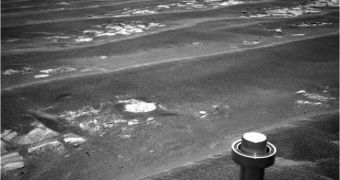Experts at the NASA Jet Propulsion Laboratory (JPL), who manage the Mars Exploration Rovers (MER) mission, say that Opportunity has just reached an amazing milestone, traveling for more than 20 miles (32.18 kilometers) on the Martian surface.
Now in its seventh year on the Red Planet, the robot was originally supposed to endure in the harsh and cold desert for only three months, back in early 2004. However, astonishing craftsmanship and a sturdy build allowed the machine to remain operational even to this day.
The mission's original distance goal was 50 times shorter than what the rover achieved on July 17. At that time, JPL mission controllers instructed Opportunity to take a 407-foot (124-meter) drive, which took it past the 20-mile mark.
At the same time, the machine is now incredibly close to the massive Endeavour crater, which has been its target for several years. At first, when experts proposed visiting the massive landscape feature, engineers controlling the rover said that the feat was nearly impossible.
While en-route, the rover took several detours, stopping for months on end to analyze scattered rocks laying on its path, as well as metallic meteorites that fell to the surface millions of years ago.
The 14-mile (22-kilometer) crater exposes numerous layers of material, that could take geologists farther down into the Red Planet's history than ever before. At this point, the robotic explorer is about 1.3 kilometers away from the crater rim.
“The numbers aren't really as important as the fact that driving so much farther than expected during this mission has put a series of exciting destinations within Opportunity's reach,” says Alfonso Herrera.
The expert is a member of the rover mission management team at JPL, and has been involved with the project since before the robot and its twin Spirit launched for the Red Planet, in 2003. He says that Opportunity can now travel faster thanks to an advanced computer program it now has.
“Autonomous hazard detection has added a significant portion of the driving distance over the past few months. It lets us squeeze 10 to 15 percent more distance into each drive,” the expert goes on to say.
“Opportunity has an arthritic shoulder joint on her robotic arm and is a little lame in the right front wheel, but she is otherwise doing remarkably well after seven years on Mars – more like 70 in 'rover years',” JPL expert Bill Nelson adds.
“The elevated right front wheel current is a concern, but a combination of heating and backwards driving has kept it in check over the past 2,000-plus sols,” adds the official, who is the chief of the MER engineering team.

 14 DAY TRIAL //
14 DAY TRIAL //